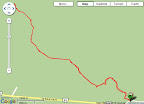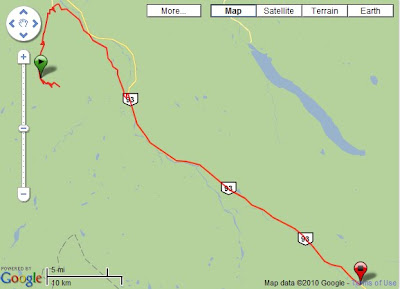I woke up bright and early and ready to hit the trail. Well, actually, I dithered a bit because I was in no hurry to get up to the ridge and then spend my time walking back and forth trying to stay warm. Nevertheless, it was 6:10 when I hit the trail, which was plenty of time to get to where I wanted to go.

Right on schedule, I hit what I considered to be a good spot at 6:50am. What's interesting was that I had made no notice of where I wanted to be the day before. I was simply making a consistent decision vis-a-vis photography from day to day, which was a good thing. I had forgotten my android phone, so I could not make ultra-long exposures consistently, but I immediately set up my tripod and got something that looked pretty good to me.
Note that it was dark enough and 30s was long enough that the stars were beginning to produce star-trails in the photograph. I shot several exposures, and started bringing out the 200mm to capture what looked like a beautiful sunrise from behind the mountains. Yes, the very mountains that were frustrating my photography.
Moments later, the sun finally started hitting the clouds and the snowscapes, and I started getting interesting alpenglow colors.
The light was changing rapidly and I worked at a furious pace, knowing that I had at most 20 minutes to capture this amazing light. I was right. By 8:20am the lightshow as over and the only thing I had left to do was to shoot a picture of myself in front of the mountains in the morning light.
I got back to the car where I met another hiker who told me that she'd been staying near the Cline River, off the Sasketchewan crossing. I made a note to look it up, knowing that I would be unlikely to find time to do it on this trip. I had 2 days left, and it was time to start driving South.
I headed South once again along the Icefield Parkway.
Petra had mentioned that the Path of the Six Glaciers was worth checking out, and had said that it was only a 4 hour walk. I could definitely manage a 4 hour walk on top of Wilcox pass. Then after that I could head down to Banff in search of more sunset beauty. The drive was uneventful. I stopped at the Sasketchewan crossing for breakfast and to charge some batteries, and then later on I stopped several times for pictures but in the later morning light it really was futile. I ended up with pictures with muddy washed out colors that wouldn't be interesting at all to anyone else.

I arrived at the Banff Visitor Information center, confirmed everything Petra had said, and proceeded to drive up to Lake Louise to start the hike. What a contrast Lake Louise was to earlier visits in the morning. The place was packed with tourists and visitors walking along the lake shore. Boats were on the water, and it looked like everyone was out. It was an overcast day, and I set a furious pace along the flat section so I could get away from the mass of tourists.
At the end of the lake, the stream feeding the lake became a delta, and the path started climbing up towards the Swiss-style tea house at the end of the trail. I learned from signboards posted on the walk that Swiss mountain guides had built the trail and the teahouse in the 1920s, which explained why everything was so well engineered and pretty. As the trail steepened I spied another hiker in front of me. She was going about the same pace I was, except that once in a while she would stop. At one of her stops she turned around and spied me, and waited for me to catch up before we started walking together. That was how I met Janice Belliveau.
Janice and I were kindred spirits, for we immediately hit it off and had great conversation that went the length of the hike. She was from Nova Scotia, from
Belliveau Cove, one of the great wooden ship building centers of the 19th and 20th century. Her father was restoring a great wooden ship for fun, even though he was not a sailor. She was here for a conference that would start tomorrow, and decided to do the hike alone because she had started hiking only a year ago. She was clearly a highly self-motivated person because she was clearly pushing the pace even though I was content to go at whatever speed she chose.
At the tea house, we stopped for some tea and chocolate cake. Intrigued by the menu item which listed
ice wine tea, I ordered some and it turned out to be exquisite. I resolved to order some as soon as I got home. Our table was next to another couple from San Francisco. Janice and I were both the kind of person who made friends easily, and soon enough all 4 of us were talking. It turned out that 3 out of the 4 of us were the same age. We enjoyed chatting with each other and exchanged information. I was delighted to see the kind of thing that Richard Wiseman talked about in
The Luck Factor used and applied directly by Janice. She would attend conferences with the goal of meeting specific people and engaging them. This was someone who took charge of her destiny and was able to seize opportunities as they came up.
Speaking of opportunities, we saw that there was a way to turn the walk into a loop instead of an out and back hike, so we took it. The return loop took us high up above the lake, where we got to see the hotel at the edge of the lake as well as the turquoise that was characteristic of a glacier fed lake. All the way down from the mountain, Janice would tell people how far they were from the summit or the tea house, all without skipping a beat in our conversation, which revolved around her business, her kids, photography, hiking, and how we chose to spend our time. At the pace she set, we were done with the hike in 4 hours, and said goodbye to each other at Lake Louise.
I drove down to the visitor center to use the washroom, and there met two cyclists who were planning to ride to Argentina (they had already finished with the Ice Field Parkway that day, and I saw them riding earlier in the day while driving down the parkway).
Justin and Nathan had not started riding together, but they were riding together for this segment. They spoke of carrying enough food to last for days, lots of great weather and good cycling. The trip was clearly to their taste and they were enjoying themselves, even though once on the coast they would likely face headwinds if the La Nina year brought early storms to the Pacific North West. We exchanged stories about touring and then I headed South for Banff.
At Banff, I stopped by the Safeway to restock for the last 2 days worth of food, more chocolate, and then went to the youth hostel to use my newly acquired hosteling international membership. At $29.70 a night it was a pretty good deal for me to get my batteries charged, a warm shower, and some indoor cooking. The weather was extremely cloudy, which led me to be pessimistic about the chances of a good photo. I moved into my room quickly and then made dinner, chatting with other random strangers in the kitchen, including a biologist who quit his job to work as a hostel manager part of the year. He managed 3 wilderness hostels, and enjoyed having the free time to relax between the rest of the year.
After dinner, I drove to Mt. Norquay in the hopes of getting a sunset, but the gray clouds were persistent. Hoping to make the best of a bad situation, I decided to aim for dusk shot of Banff.
After the shot I returned to the hostel to find that my bed had been moved. I needed a lower bunk because otherwise the power cord would not reach my CPAP machine. I moved back to the bunk and moved my stuff in. My other roommate, a woman from Sydney, told me that she'd never seen anything so rude! Well, I needed a shower so I ran off and took a shower. Unlike the shower in Jasper, the shower here was slow and only a little bit warm. I took a shower, brushed my teeth, and then headed back to my room to find my other roommates there. It turned out that it was two women traveling with
Moose Travel Network, a popular travel agency made famous by Lonely Planet. Since I didn't read Lonely Planet, I didn't know about them. Stella and Naoko (they were not traveling together, but had some itinerary in common) apologized for not understanding the etiquette of moving people around in shared accommodations, and with that the dark cloud over my hostel stay was over.
Stella was from Canton, and Naoko was from Japan but was studying in Canada. It was amusing because I speak Japanese quite a lot better than I speak Cantonese, so Naoko and I could converse a little bit while Stella and I would speak in our respective Chinese dialects. "How many other languages do you speak," asked Stella. "German and French too?" said Naoko. I said, "Just enough to get by." "I was only joking!" "Awesome!" Stella was quite a traveler, and told me a few stories of her travels in China (still a country I have yet to visit). The stories told of someone with plenty of self-confidence and resourcefulness. I usually disliked these bus tours as being dragged around by the nose, but it was clear that Stella found a way to make them work for her, as well as working around the limitations in ways I did not imagine. I showed Naoko photos from last year's
Tour of Hokkaido. She loved the look of Yubari Youth Hostel and said she would try to visit there.
The forecast did not bode well for the next day, but as always, I had to try. The tourist information office told me to drive through Kananaski Provincial Park on the way back to Glacier National Park (I was hoping for one more full sunset and sunrise there), but if you don't get up at 6:00am, you don't get to see rainbows and other nice things. So I committed to getting up again at that hour.
Previous
Next













































